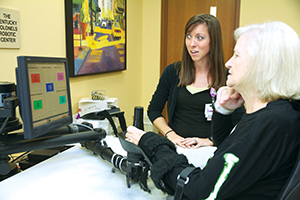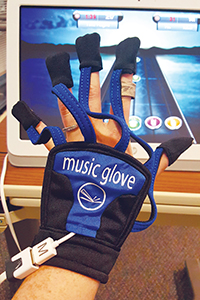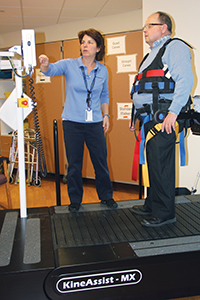By BETSY TAYLOR Great strides have been made in emergency treatment for patients suffering acute strokes. Much also is being done to harness technology to assist stroke patients during their poststroke rehabilitation. Doctors and therapists at ministry hospitals are using robotic equipment with stroke patients working to regain strength, mobility and endurance.
Several technologies assist and propel muscular-skeletal movement, giving patients a guide about the proper mechanics needed to restore motor skills. The novelty of the robotic devices, which can be paired with electronic systems that include virtual reality games, keep patients engaged in what might otherwise be monotonous therapy.

Occupational therapist Beth Thompson works with stroke patient Joyce Denton, who is playing games and using a robotic InMotion system to practice motor skills at Frazier Rehab Institute in Louisville, Ky.
That's helpful because repeating a specific task can foster neuroplasticity, the brain's ability to reorganize neural pathways based on learning and experiences. Plasticity is part of normal brain development and function, and it also is an adaptive mechanism to brain injury. Stroke rehabilitation to regain lost motor function attempts in part to foster the creation of new pathways in the brain that work around and compensate for damaged or dead neurons.
Last year Marianjoy Rehabilitation Hospital in Wheaton, Ill., invested in a new wave of robotic technology to assist rehabbing patients working to restore function after a stroke. Staff says the new devices are more responsive and easier to use than earlier technology.

At St. Joseph Hospital in Lexington, Ky., a MusicGlove is used to sharpen patients' fine motor skills. Patients pinch their fingers together to generate notes.
Dr. Jeffrey Oken, Marianjoy Rehabilitation's vice president for medical affairs, said while there is clinical evidence that the robotic rehabilitation technologies can have benefits for patients, there's no specific robotic technology related to stroke rehabilitation that's "proven to be the best at this point. You have to really use your resources carefully."
The technology ranges in price from a few hundred dollars for a basic video gaming system to hundreds of thousands of dollars for specialized robotic equipment, said Marianjoy Rehabilitation staff.
Marianjoy Rehabilitation, a freestanding 127-bed hospital that is a member of Glendale, Wis.-based Wheaton Franciscan Healthcare, has a committee that vets each piece of technology the hospital is considering for purchase. Grants and donations often help fund the technology.
Harnessing technology
Robotic technology in use at Marianjoy Rehabilitation includes the Ekso GT, a metal-framed exoskeleton that straps onto a patient's legs and torso. When the wearer is standing and shifts his weight, four motors activate in the hip and knee areas, propelling the patient forward as he relearns the mechanics of walking. Physical therapist Melissa Burns said the Ekso GT can be calibrated to a patient's body size, and if the patient cannot lift his own legs, the robotic device can help him do so, allowing the patient to experience the correct movement and to learn the correct movement patterns.

Marianjoy Rehabilitation physical therapist Terri Fetter works with a patient with a neurological diagnosis. The patient is using the KineAssist-MX for his walking and balance-related therapy.
A patient using the KineAssist-MX, a robotic gait and balance therapy device, is strapped into a harness that keeps him upright and safe from falls while he walks on a treadmill to build stability and balance. The ArmeoPower and the ArmeoSpring assist patients working to regain arm and hand movement and function. The ArmeoPower is a robotic exoskeleton that supports a patient's arm and provides graded assistance based on a patient's movement abilities, said Sarah Herron, an occupational therapist at Marianjoy. A therapist selects an ArmeoPower program to help the patient work first on basic movement and then on more complex, three-dimensional movements. It allows for high repetition training for a patient with very little upper extremity movement.
The ArmeoSpring is not robotic, rather it has a spring mechanism that counterbalances the weight of a patient's arm and provides a frictionless environment for self-initiated repetitions. It is for patients with mild to moderate impairment who wouldn't be challenged by the ArmeoPower, explained Marianjoy staff. Both the ArmeoPower and ArmeoSpring have hand attachments that are used to assist patients working to restore hand function. A patient using either the ArmeoPower or ArmeoSpring may play computer games, viewed on a screen in front of them, that respond to the motion of the equipment and its hand attachment. Data generated by the computer software allows staff to track a patient's progress.
Engaging patients
On Oct. 9, Joyce Denton, now 78, of Lebanon, Ky., had a stroke that caused partial paralysis on her left side. She spent five days at the University of Louisville Hospital before transferring for a month's stay at the Frazier Rehab Institute, both part of Catholic Health Initiatives' KentuckyOne Health. Dr. Kerri Remmel, director of the University of Louisville Stroke Center, explained stroke patients are assessed by physical therapists, occupational therapists and speech therapists within 24 hours of their admission to University of Louisville Hospital, and patients in need of therapy right away begin it as soon as they're able. Assessments are done to determine what environment a patient should be discharged to and what specialized therapy is needed.
Denton's rehabilitation included the use of a robotic InMotion system to guide her through the proper mechanics of moving her shoulder, arm, wrist and hand. "I'm here all day long, doing one thing or another," she said late last year while undergoing inpatient therapy. The robotics kept her engaged in the work, she said. "The machines really help you a lot. They give you more confidence in yourself." Denton regained some movement during her inpatient rehabilitation, she said. In early February, she continued with outpatient rehabilitation four days a week at Southern Indiana Rehab Hospital, which is partly owned by Frazier Rehab and KentuckyOne and is closer to her home.
Therapists at KentuckyOne's Saint Joseph Hospital in Lexington, Ky., employ a MusicGlove to strengthen hand movement and coordination in stroke patients. The glove has sensors in its fingers and thumb. A screen prompts fine motor movements. By pinching a finger and thumb together correctly, the patient plays the notes of a song. "When you're working on fine motor activities, they can get repetitive and a little boring," said Violet Sellers Marotta, an occupational therapist at Saint Joseph Hospital. The music glove makes therapy less onerous while rebuilding skills needed for activities of daily living, like dressing and brushing teeth. The MusicGlove also provides feedback reports that correlate with clinical measures, so therapists have data on how a patient's rehabilitation is progressing.
Looking ahead
In New Jersey, St. Joseph's Wayne Hospital, part of St. Joseph's Healthcare System, has teamed up with researchers from Rutgers University and the New Jersey Institute of Technology to study the therapeutic potential of the CyberGrasp hand exoskeleton and the HapticMASTER, as patients engage in virtual reality games and tasks.
The robotic CyberGrasp helps patients practice hand opening and finger functions. According to its website, its users feel resistive force feedback on each finger. They experience the sensation of "reaching into their computer" to grasp the size and shape of computer-generated three dimensional objects.
The HapticMASTER robot measures the force, direction and speed of a person's movements 100 times per second, and assists them or redirects them, based on how it is programmed, said Gerard Fluet, assistant professor in Rutgers' Rehabilitation and Movement Science Department. The researchers also are working to develop lower cost robots that could be used in a patient's home. They are exploring how to enhance the brain's ability to benefit from rehabilitation utilizing noninvasive brain stimulation techniques.
Dr. Supriya Massood, medical director of St. Joseph's Wayne Hospital's acute rehabilitation unit, and Jigna Patel, a research physical therapist with the Rutgers team, said the field collaboration between Rutgers, the New Jersey Institute of Technology and St. Joseph's Wayne Hospital also is exploring how to best help patients with rehabilitation of short duration during the first few weeks after a stroke.
One anecdotal observation Massood and Patel have made is that patients selected for the research using the robotic devices tend to then have a commitment to rehabilitation that spills out into other aspects of their treatment. "They're engaged with us; they're motivated," Massood said.
Copyright © 2016 by the Catholic Health Association
of the United States
For reprint permission, contact Betty Crosby or call (314) 253-3477.